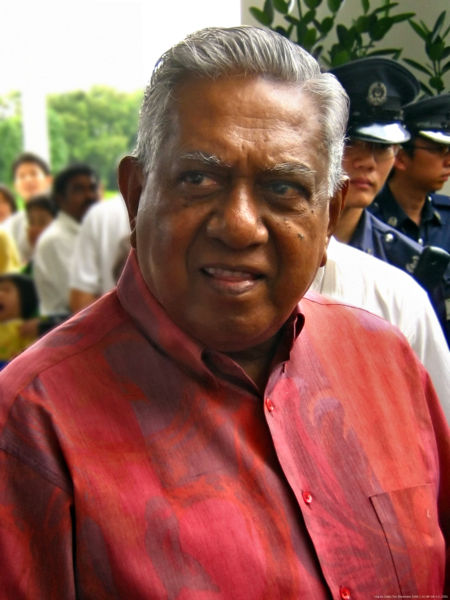<Back to Index>
- Sociologist Charlotte Perkins Gilmann 1860
- Composer Leoš Janáček, 1854
- 6th President of Singapore Sellapan Ramanathan, 1924
PAGE SPONSOR

Sellapan Ramanathan (Tamil: செல்லப்பன் ராமநாதன்; born 3 July 1924) is the sixth and current President of the Republic of Singapore. Often referred to as S. R. Nathan, he was first sworn in on September 1, 1999. In 1999 and 2005 he was proclaimed president after an uncontested election (all competing candidates disqualified). In 2009, he surpassed Benjamin Sheares to become Singapore's longest serving President.
Nathan is a Singaporean of Tamil descent; his childhood was spent with his three older sisters and parents, V. Sellapan and Apiram, in Muar, Johor, in a house overlooking the sea. His father had been posted to the Malayan town as a lawyer's clerk for a firm that serviced rubber plantations, but the Great Depression and rubber slump of the 1930s sent the family's fortunes crashing. Nathan's father accrued debts and, eventually, lost his job. The family lost money and they had to find his father a new job.
By then, the young Nathan had returned to his birthplace, Singapore, to live, and received his primary and earlier education in Anglo - Chinese Primary School in Singapore as well as the Rangoon Road Afternoon School, and his secondary/senior high school education at Victoria School. He started working before completing his studies. During the Japanese Occupation of Singapore, Nathan worked for the Japanese civilian police as a translator. After the war, whilst working, he completed his secondary education through self-study, and entered the University of Malaya (then in Singapore) where he graduated in 1954 with a Diploma in Social Studies (Distinction).
Nathan began his career in the Singapore Civil Service as
a medical social worker in 1955. He was appointed Seamen's Welfare
Officer the following year. In 1962, he was seconded to the Labour
Research Unit of the Labour Movement, first as Assistant Director and
later Director of the Labour Research Unit until January 1966. He
continued as a Member of its Board of Trustees until April 1988. In
February 1966, he was transferred to the Foreign Ministry. He served as
Assistant Secretary and rose to be Deputy Secretary before being
appointed Acting Permanent Secretary of the Ministry of Home Affairs in
January 1971. In August of the same year, Nathan moved to the Ministry
of Defence where he was Director of the Security and Intelligence Division (SID), with the rank of Permanent Secretary. He was involved in the Laju incident on January 31, 1974, when members of the terrorist Japanese Red Army (JRA) bombed petroleum tanks on Pulau Bukom off
the coast of Singapore. Nathan, was among a group of government
officers who volunteered to be held hostage by the JRA to secure the
release of civilian hostages. In
February 1979, he returned to the Ministry of Foreign Affairs and
became its First Permanent Secretary until February 1982 when he left
to become the Executive Chairman of the Straits Times Press (1975) Ltd,
the Singapore newspaper company. At various times from 1982 to 1988,
Nathan also held directorship of several other companies including the
Singapore Mint Pte Ltd, The Straits Times Press (London) Ltd, Singapore Press Holdings Ltd
and Marshall Cavendish Ltd. He held a directorship in the Singapore
International Media Pte Ltd between September 1996 and August 1999. He
was Chairman of Mitsubishi Heavy Industries Singapore — a ship repairing and engineering joint venture with the Mitsubishi Group of Japan, from 1973 to 1986. From 1983 to April 1988, Nathan was Chairman of the Hindu Endowments Board. He was a founding member of SINDA – the Singapore Indian Development Association – and its Term Trustee until August 1999. In April 1988, Nathan was appointed Singapore's High Commissioner to Malaysia and, in July 1990, became Ambassador to the United States of America where he served until June 1996. On his return, Nathan was made Ambassador-at-Large and was concurrently Director of the Institute of Defence and Strategic Studies at the Nanyang Technological University.
He resigned as Ambassador-at-Large and Director of the Institute on
August 17, 1999, and was appointed, as the only eligible candidate and,
thus, unopposed, President of the Republic of Singapore on August 18,
1999. Nathan was conferred with the Public Service Star in 1964, the Public Administration Medal (Silver) in 1967, and the Meritorious Service Medal in 1974. Although a Straits Times survey
showed that nearly 80 per cent of Singaporeans hoped for a contest,
Nathan nonetheless took up office unopposed as President on August 18,
1999. His nomination was strongly supported by Senior Minister Lee Kuan Yew. He succeeded the fifth President of Singapore, Ong Teng Cheong, and was sworn in on September 1, 1999. On July 12, 2005, Nathan announced that he was seeking re-election as President. He submitted an eligibility application to the Presidential Elections Committee;
by August 6, 2005, three more people had also submitted forms, but on
August 13, 2005, the Committee announced that the other three
applicants had been rejected as ineligible. Nathan returned unopposed
on nomination day, August 17, 2005. He was sworn in for a second term
of office on September 1, 2005.
After
Nathan's appointment as President of Singapore, he took interest in
building a caring society for the nation. He started the President's Challenge initiatives
in 2000. The initiative has been a success so far, raising over $80
million dollars for more than 400 of its beneficiaries.
Nathan, a Tamil, is married to Urmila (Umi) Nandey, a Bengali of Indian descent, and has a daughter, a son, and three grandchildren.